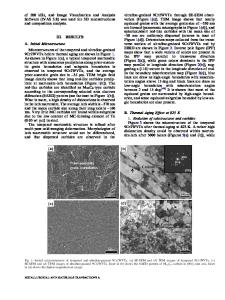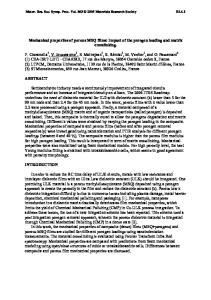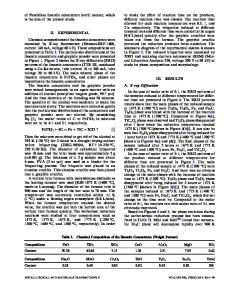Mechanical Properties Evolution of Polydimethylsiloxane during Crosslinking Process
- PDF / 243,854 Bytes
- 7 Pages / 612 x 792 pts (letter) Page_size
- 97 Downloads / 457 Views
0975-DD06-07
Mechanical Properties Evolution of Polydimethylsiloxane during Crosslinking Process Yi Zhao1 and Xin Zhang2 1 Department of Biomedical Engineering, The Ohio State University, 1080 Carmack Road, Columbus, OH, 43210 2 Department of Manufacturing Engineering, Boston University, 15 Saint Mary's Street, Brookline, MA, 02446 ABSTRACT This paper reports mechanical properties evolution of polydimethylsiloxane (PDMS) during crosslinking process. In this work, PDMS crosslinking was induced by mixing base prepolymer and curing agent at certain ratios. The liquid prepolymer was spin coated on a silicon wafer; the curvature change of the wafer was measured continuously using a curvature measurement system. The relationship between the curvature change and typical mechanical properties was investigated using a bilayer model, and the evolution of the properties was derived as a function of operational parameters during the process. This work is expected to help better understanding of thermal induced crosslinking and provide practical strategies for controlling the mechanical behavior of resulting polymer structures, especially those for mechanical sensing applications.
INTRODUCTION Polydimethylsiloxane (PDMS) is one of the most widely used materials in microfluidic systems. The typical advantages of PDMS over other materials include low cost, optical transparency and relatively easy manufacturability. PDMS microstructures are usually fabricated using replication based methods, such as replica molding [1] or MIMIC [2]. During these processes, the prepolymer is first mixed at certain ratios with the curing agent, and then exposed to thermal or UV irradiation. The mechanical properties of the resulting PDMS micro/nano structures largely depend on the operational parameters during the curing process. Due to the small elastic modulus of PDMS materials (of the order of 1 MPa), there has been increasing use of PDMS micro/nano structure as mechanosensors to detect mechanical forces at small scales, especially to measure the forces generated by cellular and subcellular units [3]. To this end, the mechanical properties of the PDMS micro/nano structures need to be determined with high precision, to give a quantitative measure of such forces. However, there is so far little study about relationships between mechanical properties of PDMS (e.g. elastic modulus, Poissonís ratio, coefficient of thermal expansion) and the operational parameters of the crosslinking process (e.g. thermal loading profile). This is partially due to lack of appropriate approaches for continuously detecting these mechanical properties during the crosslinking process. In this paper, we introduce a method to enable continuous determination of typical mechanical properties of PDMS during a thermal curing process, by innovative use of a curvature measurement system. The changes of mechanical properties were derived from curvature change of a silicon base substrate, which was induced by mechanical interaction between the silicon wafer and the subject PDMS lay
Data Loading...











